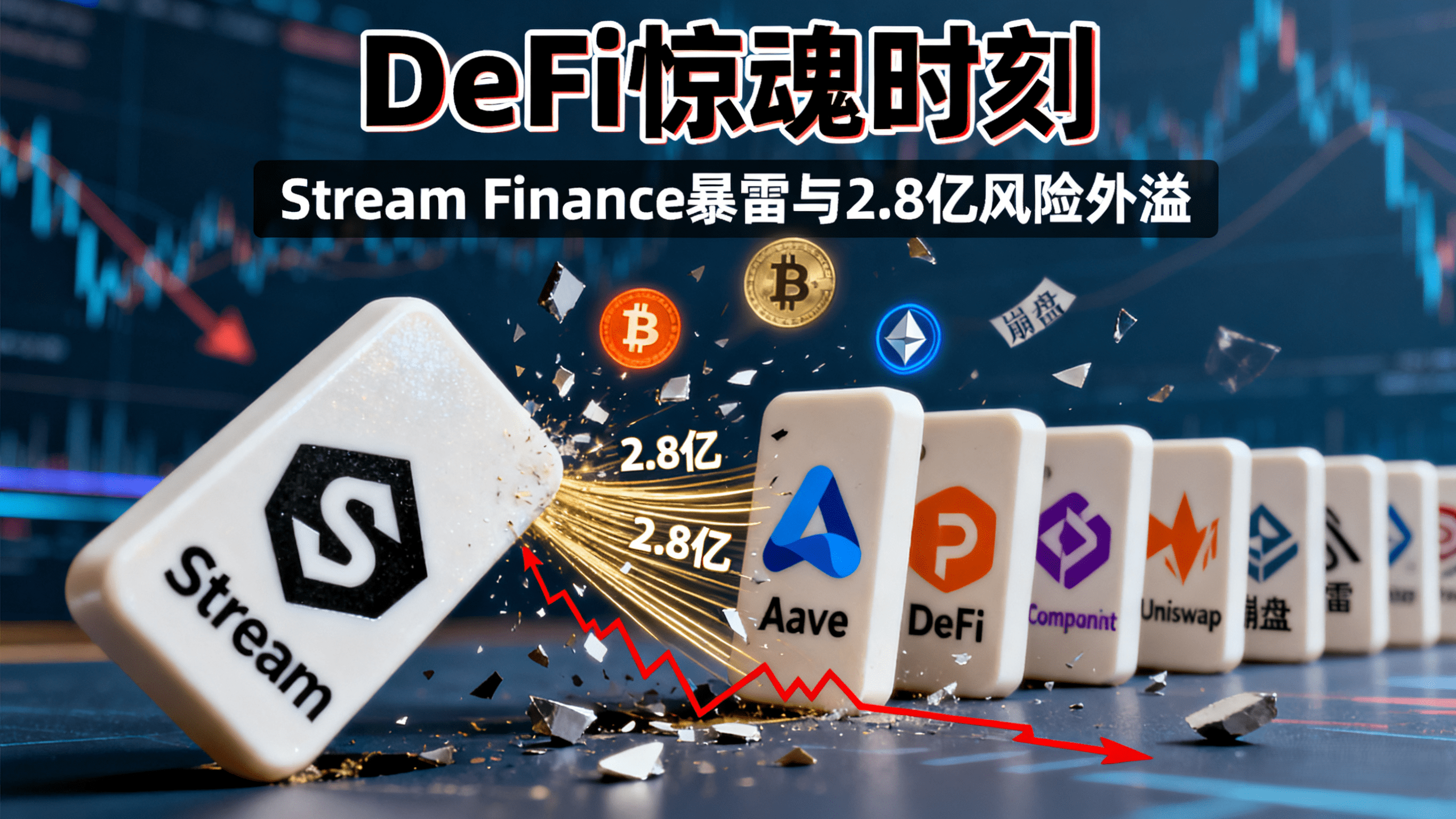Friends, dawn is approaching, this is Azu. Let's get straight to the point! In November 2025, the DeFi circle will stir up a storm again. Stream Finance suddenly announced that the external fund manager suffered a loss of up to 93 million USD, and immediately suspended deposit and withdrawal services. The yield-bearing stablecoin xUSD issued by them significantly depegged in a short period, with a maximum drop of 77%. This crisis, which began on a single platform, quickly raised concerns about the $280 million cross-protocol associated positions, and under the chain reaction, the risk transmission mechanism of the DeFi ecosystem has once again become the focus.

1. The Beginning and End of the Storm: From a 93 Million Gap to Panic Across the Market
The collapse of Stream Finance was not without warning; it was an inevitable result of multiple risks stacking up. The direct trigger for the incident was the huge losses of the external fund manager. After this news broke, the platform quickly took emergency measures to halt deposits and withdrawals, which further intensified market panic.
As the core product of the platform, xUSD should have maintained a stable peg to the US dollar, but shortly after the announcement, it deviated by more than 25%, with a nearly 'halved' drop during peak periods, causing significant losses for many users holding or collateralizing xUSD. Even more concerning is that 'x series' tokens like xUSD and xBTC are widely used in collateral scenarios of other DeFi protocols, with a potential impact scale of about $280 million, raising market concerns that the crisis could spill over to the entire ecosystem.
2. Roots of the Collapse: Three Fatal Weaknesses Behind DeFi's High Returns
The collapse of Stream Finance exposed the hidden deep structural risks behind seemingly attractive profit models of some DeFi platforms.
1. Outsourced Wealth Management: A Fatal Flaw in Delegating Risk Control
The platform has entrusted part of its revenue-generating business to external managers but lacks effective on-chain verification mechanisms and risk control constraints. This model is akin to handing over the 'braking authority' of funds, and if the external manager makes a mistake or faces moral hazards, the platform will directly face massive losses, and the safety of users' funds will also be compromised.
2. Re-collateralization Cycle: Leveraged Risk Transmission Amplification
'x series' tokens allow users to repeatedly collateralize across protocols, amplifying returns through layers of leverage while also causing risks to grow exponentially. When xUSD decouples and collateral values are adjusted downwards, cross-platform collateral positions will trigger a chain of margin calls and liquidations, creating a domino effect of 'one collapse leads to total loss.'
3. Liquidity Run: The 'Vacuum of Buyers' in Extreme Moments
The liquidity of the platform's core assets is excessively concentrated, lacking a decentralized layout and emergency reserve mechanism. During market panic, user withdrawals lead to liquidity depletion, with insufficient funds to absorb sell-offs, further exacerbating asset price declines and decoupling, plunging the crisis into a vicious cycle.
3. Market Resonance: Risk Amplification Effect Under Negative Narratives
It is worth noting that the collapse of Stream Finance coincided with a $120 million vulnerability attack on the Balancer protocol. Although the two are not directly causally related, in the sensitive environment of the DeFi market where 'liquidity + confidence' is crucial, negative events create resonance effects.
Investors' risk aversion sentiment was quickly ignited, and funds began to withdraw from high-risk protocols, further tightening the already fragile market liquidity. This emotional transmission escalates a crisis in a single platform into an industry-wide panic, highlighting the speed and destructiveness of risk transmission across protocols under the deeply coupled DeFi ecosystem.
4. A Guide for Ordinary People to Avoid Pitfalls: Five Dimensions to Strengthen Safety Lines
Behind the high returns of DeFi, there has always been high risk. The case of Stream Finance serves as a wake-up call for all investors, emphasizing the need to take the following five points to protect their assets in a volatile market.
1. Penetrating Verification Platform Mechanism
Pay close attention to whether the platform has a model of outsourced fund management, check whether its risk control indicators can be validated through on-chain data, and confirm whether the platform clearly announces emergency plans for extreme scenarios, including conditions for halting deposits and withdrawals and recovery mechanisms.
2. Beware of Over-leveraged Assets
For assets that can be repeatedly collateralized and generate returns cyclically, it is necessary to carefully assess their leveraged risk transmission. Understand the collateral paths and related protocols of the assets to avoid holding or collateralizing high-risk tokens that become 'uncoupled with no buyers.'
3. Decentralized Layout Liquidity
Avoid concentrating funds in a single liquidity pool or protocol. Prioritize platforms that have decentralized liquidity, insurance reserves, or emergency risk control switches to reduce the risk of a run in extreme situations.
4. Keep a Close Eye on Information Disclosure Quality
Choose platforms that continuously update reserve and liability data. During extreme events, clear, timely, and executable announcements can effectively reduce market panic, while vague responses often signal risk expansion.
5. Evaluate Ecological Coupling Risks
Stay away from high-risk products deeply bound to multiple protocols. Analyze the degree of association between the target platform and protocols such as lending and derivatives, to avoid having assets liquidated across platforms due to a single protocol's collapse.
The core appeal of DeFi lies in the efficiency and freedom brought by decentralization, but this does not mean that risk control can be ignored. The collapse of Stream Finance once again proves that high returns can never be detached from safety boundaries. For ordinary people, respecting risks, penetrating essence, and diversifying layouts are the core rules for navigating through industry cycles.
#XUSD #stream

